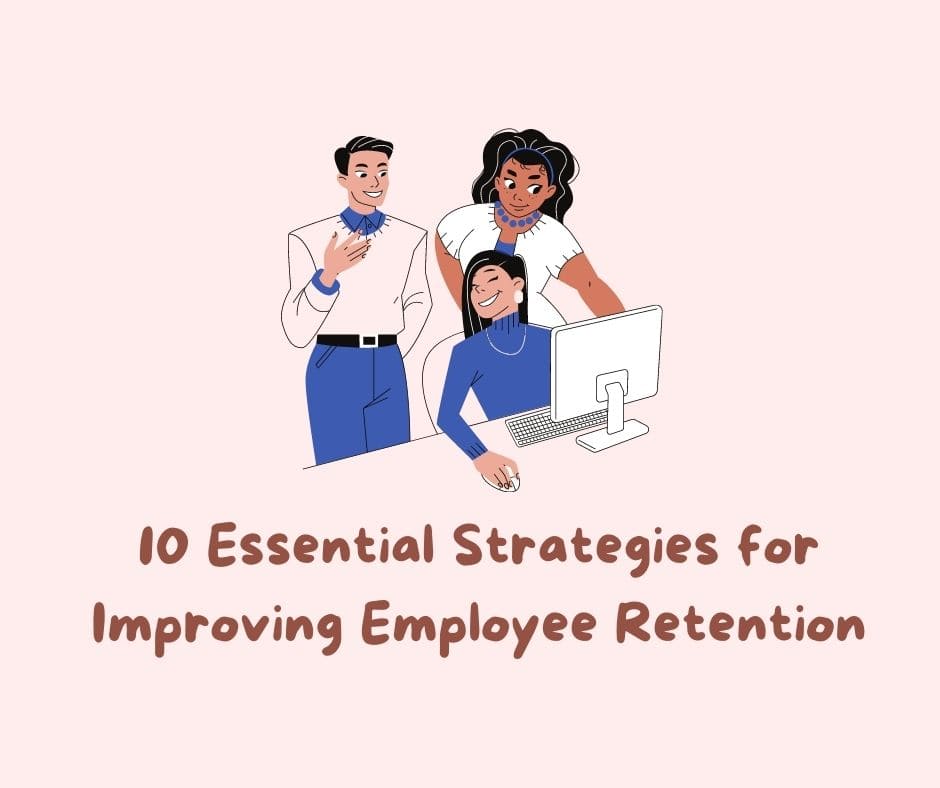10 Essential Strategies for Improving Employee Retention
Employee retention is a critical component of any thriving business. However, it can be difficult to sustain low attrition rates – particularly considering the propensity of millennials and Gen Zers to job-hop. Nevertheless, keeping employees motivated and engaged in their jobs is essential for boosting productivity, morale, and overall job satisfaction, as well as reducing costs associated with recruiting and training new staff. As such, implementing effective strategies for employee retention is the best way to retain high-quality talent and remain competitive. In this article, we will explore ten essential strategies for improving employee retention rates and discuss how each one contributes to the success of your business.
Table of Contents
Enhance Training and Development Opportunities
Employees who feel they can grow professionally within an organization are more likely to stay. Therefore, investing in ongoing training and development opportunities is a great way to give employees the support they need to reach their full potential. Providing opportunities for further education or even sending employees offsite for professional development seminars are all great ways to show that you value your staff members’ careers.
Encourage Work-Life Balance for Improving Employee Retention
A healthy work-life balance is essential for keeping staff happy and motivated in their jobs. Offering flexible hours or remote working arrangements can help prevent burnout. Because it is allowing employees some freedom over when they complete tasks while still meeting deadlines. Companies should also consider introducing perks like generous vacation policies, wellness days, and even paid leave for staff members to use when they need a break.
Offer Competitive Compensation Packages
No matter what industry you operate in, one of the main compensation objectives of your salary and benefits packages should be to attract and retain top talent. After all, the vast majority of employees will look for the best salary and benefits when considering new positions. So it’s essential to make sure your packages remain competitive if you want to attract and keep high-quality talent.
On top of this, offering monetary bonuses or salary increases in recognition of good performance can help employees feel appreciated while motivating them at the same time. Salaries alone might not be enough since many people now place importance on other benefits such as health insurance or access to retirement funds when considering whether or not they should stay with an employer long-term.
Communicate High Expectations and Hold Employees Accountable
By clearly communicating expectations from day one, employees have a clear understanding of what needs to be achieved from them which eliminates the chance for misunderstandings down the line.
Employees who do not meet expectations should be held accountable through well-defined disciplinary procedures so that their colleagues know there are repercussions for not doing their job properly. This creates a sense of fairness among workers which helps keep morale high; after all, no one likes feeling like certain rules don’t apply equally across teams or departments.
Support Employee Career Goals for Improving Employee Retention
Employees want career progression just as much as companies want dedicated staff members. Supporting employee career goals shows that you value their role in helping achieve company goals. And also potentially expanding your workforce by promoting internally whenever possible. This has twofold benefits. Financial (as it reduces recruitment costs) but also cultural benefits (as there’s less disruption due to having more experienced workers).
In addition, consider setting up mentoring programs or offering skills workshops where staff members can learn new skills relevant to future roles within the company – this will give them both motivation and confidence that you are invested in their success within the organization over time.
Implement Employee Recognition Programs
Recognizing employee performance is a surefire way to boost morale. As well as job satisfaction levels among staff members. This often results in improved productivity. Introducing recognition programs such as ‘Employee Of The Month’ awards encourages competition between colleagues. This can help bring out the best in individuals. While also fostering a sense of camaraderie among team members.
Create Open Communication Channels
Open communication channels create an environment where staff feels comfortable expressing themselves without fear of judgmental feedback from managers. This helps build trust among team members for improving employee retention. While creating an inclusive culture where everyone feels valued regardless of job title or seniority level within an organization.
Encourage open dialogue, such as implementing regular team meetings or creating an intranet forum where employees can submit anonymous suggestions and ask questions. Doing this encourages collaboration and creates a platform for employees to share ideas that could potentially benefit the business in the long run.
Provide Clear Direction and Leadership
When there is a lack of direction from senior management, it sends out mixed messages about what needs doing at any given time. This is leading to confusion among workers. To ensure everything runs smoothly throughout your operations, set realistic goals that are communicated clearly to employees. While also regularly assessing progress so that all of your personnel know how they’re performing.

Ambiguity and lack of structure can be extremely off-putting to staff. So it’s important to have a clear plan in place that everyone is aware of. This will help ensure that team goals are met while also avoiding any potential disputes or misunderstandings.
Encourage Positive Interpersonal Relationships Among Colleagues
A friendly, cohesive workplace is key for boosting employee morale and productivity. Encourage staff members to get to know each other by setting up team-building activities. Or providing opportunities for them to collaborate on tasks for improving employee retention. Even something as simple as an office team lunch can help create a better work environment. If employees feel connected to each other, it can help foster a sense of trust and collaboration. Something which goes a long way toward improving the overall atmosphere in a workplace.
Leverage Technology So Employees Can Focus On Higher-Value Tasks
The right technology can help streamline processes, freeing up valuable time that employees would otherwise spend completing mundane tasks. By leveraging automation and AI solutions, staff can focus on more complex tasks that require critical thinking and creativity. While allowing machines to take care of the routine tasks. This helps employees feel more involved in the company’s work. Something which can help significantly improve their overall job satisfaction levels.
Final Words on Improving Employee Retention
Employee retention and engagement are key metrics that all organizations should strive for to ensure they remain competitive in the market. By implementing the strategies outlined above, employers can create a positive work culture where staff feels valued, appreciated, and empowered to do their best work. Just remember that employee engagement and retention is an ongoing process. So don’t forget to keep track of your progress and make adjustments as needed.

David is a dynamic, analytical, solutions-focused bilingual Financial Professional, highly regarded for devising and implementing actionable plans resulting in measurable improvements to customer acquisition and retention, revenue generation, forecasting, and new business development.










